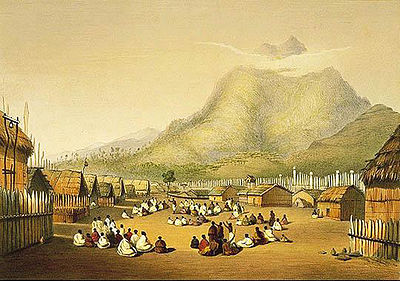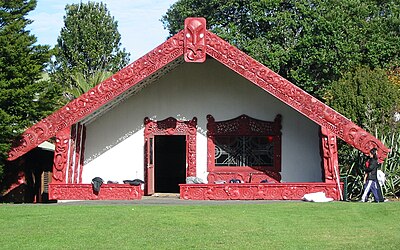AY Honors/Māori Lore/Answer Key
A marae (in New Zealand Māori, Cook Islands Maori, Tahitian) malaTemplate:Okinae (in Tongan), malae (in Samoan and Hawaiian) is a sacred place which served both religious and social purposes in ancient Polynesian societies. In all these languages, the word also means "cleared, free of weeds, trees, etc." It generally consists of an area of cleared land roughly rectangular (the marae itself), bordered with stones or wooden posts (called au in Tahitian and Cook Islands Māori) and containing a central stone (ahu, a'u)& and sometimes terraces (paepae) used in olden times for ceremonial purposes. During the 1994 restoration of Taputapuātea marae at Ra'iātea by archaeologists from the Tahiti Museum, human bones were discovered under some of the structures; apparently, the remains of sacrifices to Template:OkinaOro.
In some modern Polynesian societies, notably that of the Māori of New Zealand, the marae is still a vital part of everyday life. However, in tropical Polynesia, most marae were destroyed or abandoned with the arrival of Christianity in the 19th Century and some of them have become an attraction for tourists or archeologists. Nevertheless, the place where the marae were built are still considered as tapu in most islands and nobody would dare build anything on it. In the Cook Islands, a few marae (Arai-te-tonga, Vaerota, Taputapuātea&) are still maintained, and are quickly tidied up before the investiture of a new ariki.
Marae in New Zealand
In Māori society, the marae is a place where the culture can be celebrated, where the Māori language can be spoken, where intertribal obligations can be met, where customs can be explored and debated, where family occasions such as weddings and birthdays can be held, and where important ceremonies, such as extending a formal welcome to visitors or farewelling the dead, can be performed. Like the related institutions of old Polynesia, the marae is a wāhi tapu, a 'sacred place' which carries great cultural meaning.
In Māori usage, marae is technically the enclosed space in front of a wharenui or meeting house (literally "big house"). However, it is generally used to refer to the whole complex, including the buildings and the open space.& An unambiguous term for the area in front of the wharenui is marae ātea. This area is used for pōwhiri - welcome ceremonies featuring oratory. Some marae do not allow women to perform oratory there. The meeting house is the locale for important meetings, sleepovers, and craft and other cultural activities. The wharekai (dining hall) is used primarily for communal meals, but other activities may be carried out there. Many of the words associated with marae in tropical Polynesia are retained in the Māori context. For example, the word paepae refers to the bench where the speakers sit; this means it retains its sacred and ceremonial associations.
Legal status
A marae is a meeting place registered as a reserve under the Te Ture Whenua Maori Act of 1993 ('The Māori Land Act'). Each marae has a group of trustees who are responsible for the operations of the marae. The act governs the regulation of marae as reservations and sets out the responsibilities of the trustees in relation to the beneficiaries. Generally each marae has a charter which the trustees have negotiated with the beneficiaries of the marae. The charter details matters such as:
- the name of the marae, and a description of it;
- a list of the beneficiaries: usually iwi (tribes), hapū (sub-tribes) or whānau (families); in some cases, in a few cases, the marae is dedicated to the common good of the people of New Zealand.
- the methods used to select trustees;
- general governing principles of the marae;
- the ways in which the trustees may be held accountable by the beneficiaries, and methods for conflict resolution;
- principles governing appointment and recognition of committees to administer the marae;
- procedures for amending the charter, and for ensuring adherence to its principles.
Tribal, church, and educational uses
Most tribes and subtribes and even many small settlements have their own marae. An example of such a small settlement with its own marae is at Hongoeka Bay, Plimmerton, the home of renowned writer Patricia Grace. Since the second half of the 20th century, Māori in urban areas have been establishing intertribal marae such as Maraeroa in eastern Porirua. For many Māori, the marae is just as important to them as their own homes.
Some New Zealand churches also operate marae of their own, in which all of the functions of a traditional marae are carried out. Churches operating marae include the Anglican, Presbyterian, and Catholic churches. In recent years, it has become common for educational institutions, including primary and secondary schools, technical colleges, and universities, to build marae for the use of the students and for the teaching of Māori culture. These marae may also serve as a venue for the performance of official ceremonies relating to the school. The marae of the University of Auckland, for instance, is used for graduation ceremonies of the Māori Department, as well as welcoming ceremonies for new staff of the University as a whole. Its primary function is to serve as a venue for the teaching of whaikōrero (oratory), Māori language and culture, and important ceremonies for distinguished guests of the University.
Polynesian Marae picture gallery
(To complete)
New Zealand
Society Islands
- TaputapuateaMarae02.jpg
"Taputapuātea, an ancient marae at Ra'iātea (Opoa district) restored in 1994"
- TaputapuateaMarae01.jpg
"A ti'i on the Taputapuātea marae (Ra'iātea)"
Cook Islands
- Taputapuatea-a'u.jpg
"Te a'u central stone of Taputapuātea marae (Rarotonga). This stone would have been brought by Tangi'ia from Raiatea in XIIIth century"
- Maungaroa.jpg
Marae called "Maungaroa ki tai i te opuanga o te rā". It was the marae of the Tinomana Ariki (Puaikura tribe-Rarotonga). It was restored in the seventies after having been destroyed through the zeal of the missionaries.
- Vaerota.jpg
"Vaerota marae(Ngatangiia-Rarotonga). Kainuku Ariki's marae located in the Avana Valley"&
"Arai te Tonga marae(Tupapa Valley-Rarotonga)"&
- Tangoitetipi.jpg
"Tangi o te Tipi marae (Arorangi -Rarotonga). A well maintained Marae located long te ara metua about Akaoa Tapere"
- Tangoitetipi1.jpg
"Tangi o te Tipi marae (Akaoa Arorangi - Rarotonga). Pera mataiapo tutara's marae"
See also
External links
- NaumaiPlace.com; connecting whanau memebers with their maraes world wide.
- New Zealand in History: the marae - meeting place
- Gérard, Bertrand, Le marae : description morphologique in Cahiers des Sciences Humaines, 1978, Vol. 15, No 4, p. 407-448. Architecture and morphology of Society Islands Marae
- John Joseph Knight Hutchin, E Tuatua no te apai atinga ki mua i te marae, i te tuatau etene anga ("Tale of the offerings at the marae in heathen time") in "Collected songs and legends from the southern Cook Islands (c. 1883-1912)", notebook 2
Notes
- ↑ In some sources the word "ahu" is used as a synonym for all the stone structure of a marae complex
- ↑ Rarotongan tradition holds that Taputapuātea marae at Rarotonga, which archaeologists have dated to the 13th century, was built by Tangi'ia who brought the central stone with him from the ancient marae of the same name at Ra'iātea.Indeed, it seems that it was quite usual in ancient times to take a stone from this marae. The son of Tetupaia and Teu had not only the right to a seat in the great Marae of Taputapuatea in Raiatea, but he could take his stone from Taputapuatea and set it up in his own district of Pare Arue (Tahiti), so founding a Marae Taputapuatea of his own to wear the Maro-'ura (red waist girdle of the ariki)in. Ta'aroa Marau, "Memoirs of Arii Tamai e marama of Eimo Teriirere of Tooarai Terinui of Tahiti Tauraatua i Amo"
- ↑ This sense of the word is now common in New Zealand English. Like nearly all Māori words, it is unchanged in the plural.
- ↑ The picture is taken from inside the marae which is enclosed with yellow hibiscus trees (au)
- ↑ Arai te tonga was actually the name of the koutu ariki (ariki's court). It originally comprised a considerable area of land, within three marae were built whose name were "Pure Ora", "Murivai" and "Marae Koroa" (Stephen Savage). This picture show the only visible marae today and generaly known under the name Arai te Tonga. According to some contradictory traditions the koutu was built by Tangi'ia or Karika. By the way it is located at the ancient border of the Takitumu (Ngati Tangi'ia) and Te au o tonga (Ngati Karika) tribes which is now situated at Matavera"
References
- Hirini Moko Mead, 2003. Tikanga Māori: Living by Māori Values. Huia Publishers: Wellington.






